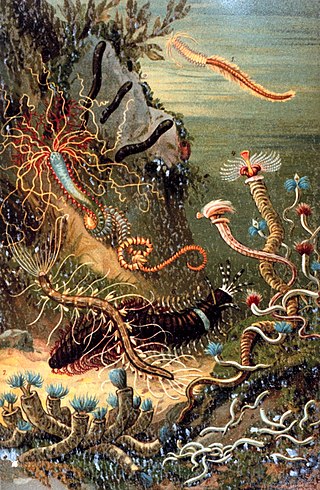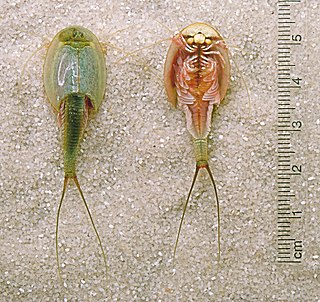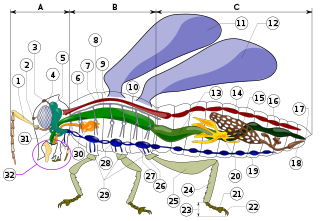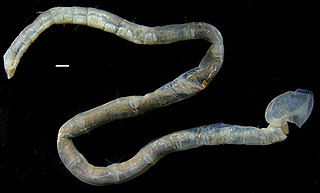
Polychaeta is a paraphyletic class of generally marine annelid worms, commonly called bristle worms or polychaetes. Each body segment has a pair of fleshy protrusions called parapodia that bear many bristles, called chaetae, which are made of chitin. More than 10,000 species are described in this class. Common representatives include the lugworm and the sandworm or clam worm Alitta.

Eurypterids, often informally called sea scorpions, are a group of extinct arthropods that form the order Eurypterida. The earliest known eurypterids date to the Darriwilian stage of the Ordovician period 467.3 million years ago. The group is likely to have appeared first either during the Early Ordovician or Late Cambrian period. With approximately 250 species, the Eurypterida is the most diverse Paleozoic chelicerate order. Following their appearance during the Ordovician, eurypterids became major components of marine faunas during the Silurian, from which the majority of eurypterid species have been described. The Silurian genus Eurypterus accounts for more than 90% of all known eurypterid specimens. Though the group continued to diversify during the subsequent Devonian period, the eurypterids were heavily affected by the Late Devonian extinction event. They declined in numbers and diversity until becoming extinct during the Permian–Triassic extinction event 251.9 million years ago.
In biology, a tagma is a specialized grouping of multiple segments or metameres into a coherently functional morphological unit. Familiar examples are the head, the thorax, and the abdomen of insects. The segments within a tagma may be either fused or so jointed as to be independently moveable.
This glossary of ichthyology is a list of definitions of terms and concepts used in ichthyology, the study of fishes.

The anatomy of spiders includes many characteristics shared with other arachnids. These characteristics include bodies divided into two tagmata, eight jointed legs, no wings or antennae, the presence of chelicerae and pedipalps, simple eyes, and an exoskeleton, which is periodically shed.

Triops longicaudatus is a freshwater crustacean of the order Notostraca, resembling a miniature horseshoe crab. It is characterized by an elongated, segmented body, a flattened shield-like brownish carapace covering two thirds of the thorax, and two long filaments on the abdomen. The genus name Triops comes from Greek ὤψ or ṓps, meaning "eye" prefixed with Latin tri-, "three", in reference to its three eyes. Longicaudatus is a Latin neologism combining longus ("long") and caudatus ("tailed"), referring to its long tail structures. Triops longicaudatus is found in fresh water ponds and pools, often in places where few higher forms of life can exist.

Radiodonta is an extinct order of stem-group arthropods that was successful worldwide during the Cambrian period. Radiodonts are distinguished by their distinctive frontal appendages, which are morphologically diverse and were used for a variety of functions. Radiodonts were among the earliest large predators, but they also included sediment sifters and filter feeders. Some of the most famous species of radiodonts are the Cambrian taxa Anomalocaris canadensis, Hurdia victoria, Peytoia nathorsti, Titanokorys gainesi, Cambroraster falcatus and Amplectobelua symbrachiata. The later surviving members include the subfamily Aegirocassisinae from the Early Ordovician of Morocco and the Early Devonian member Schinderhannes bartelsi from Germany.

Opheliidae is a family of small, annelid worms. Some of the genera, like Armandia, Ophelina and Polyophthalmus, have lost their circular muscles. The Opheliidae family of polychaete; marine annelid worms, play an essential role in marine ecosystems as “deposit feeders” that aid in the recycling of nutrients and sediment mixing in muddle and sandy habitats. Due to their distinctive adaptations that include streamlined bodies and specialized muscles they can burrow in various marine environments.

Insect morphology is the study and description of the physical form of insects. The terminology used to describe insects is similar to that used for other arthropods due to their shared evolutionary history. Three physical features separate insects from other arthropods: they have a body divided into three regions, three pairs of legs, and mouthparts located outside of the head capsule. This position of the mouthparts divides them from their closest relatives, the non-insect hexapods, which include Protura, Diplura, and Collembola.
This glossary describes the terms used in formal descriptions of spiders; where applicable these terms are used in describing other arachnids.

Cirratulidae is a family of marine polychaete worms. Members of the family are found worldwide, mostly living in mud or rock crevices. Most are deposit feeders, but some graze on algae or are suspension feeders. Although subject to multiple revisions over time, cirratulids are among the few polychaete clades with a verified fossil record.

Arenicolidae is a family of marine polychaete worms. They are commonly known as lugworms and the little coils of sand they produce are commonly seen on the beach. Arenicolids are found worldwide, mostly living in burrows in sandy substrates. Most are detritivores but some graze on algae.

Abarenicola pacifica or the Pacific lugworm is a large species of polychaete worm found on the west coast of North America and also in Japan. The worms live out of sight in burrows under the sand and produce casts which are visible on the surface.

Orbiniidae is a family of polychaete worms. Orbiniids are mostly unselective deposit feeders on marine detritus. They can be found from the neritic zone to abyssal depths.

Spionida is an order of marine polychaete worms in the infraclass Canalipalpata. Spionids are cosmopolitan and live in soft substrates in the littoral or neritic zones.

Maldanidae is a family of more than 200 species of marine polychaetes commonly known as bamboo worms or maldanid worms. They belong to the order Capitellida, in the phylum Annelida. They are most closely related to family Arenicolidae, and together form the clade Maldanomorpha.

Maldanomorpha is a monophyletic group, or clade, of polychaete worms in the phylum Annelida. Several phylogenetic analyses based on morphological and molecular data have shown that this clade unites the families Arenicolidae and Maldanidae. The two main synapomorphies, morphological characters described to unite both families, are a lecithotrophic larval development and the presence of an uncinus, a hook-like structure with barbs.

Orbiniida is an order of small polychaete worms in the phylum Annelida. It is the earliest diverging clade in Sedentaria. Along with Protodriliformia, this order is composed of meiofaunal marine worms formerly known as "archiannelids". These worms inhabit the marine interstitial ecosystem, the space between sand grains.















